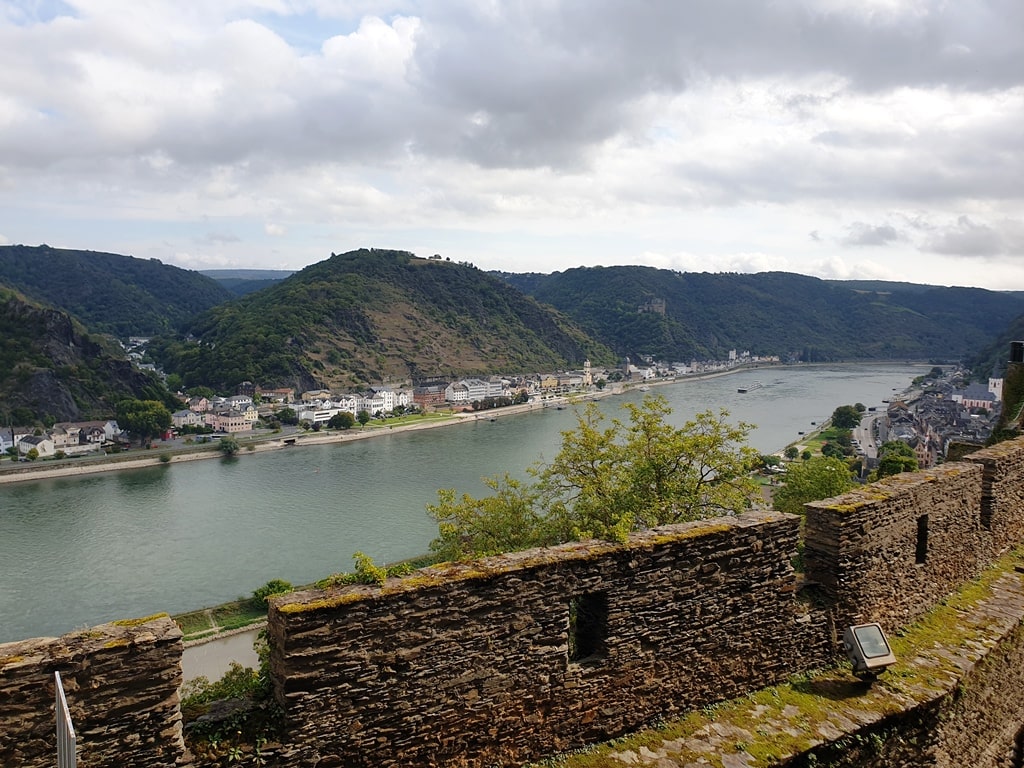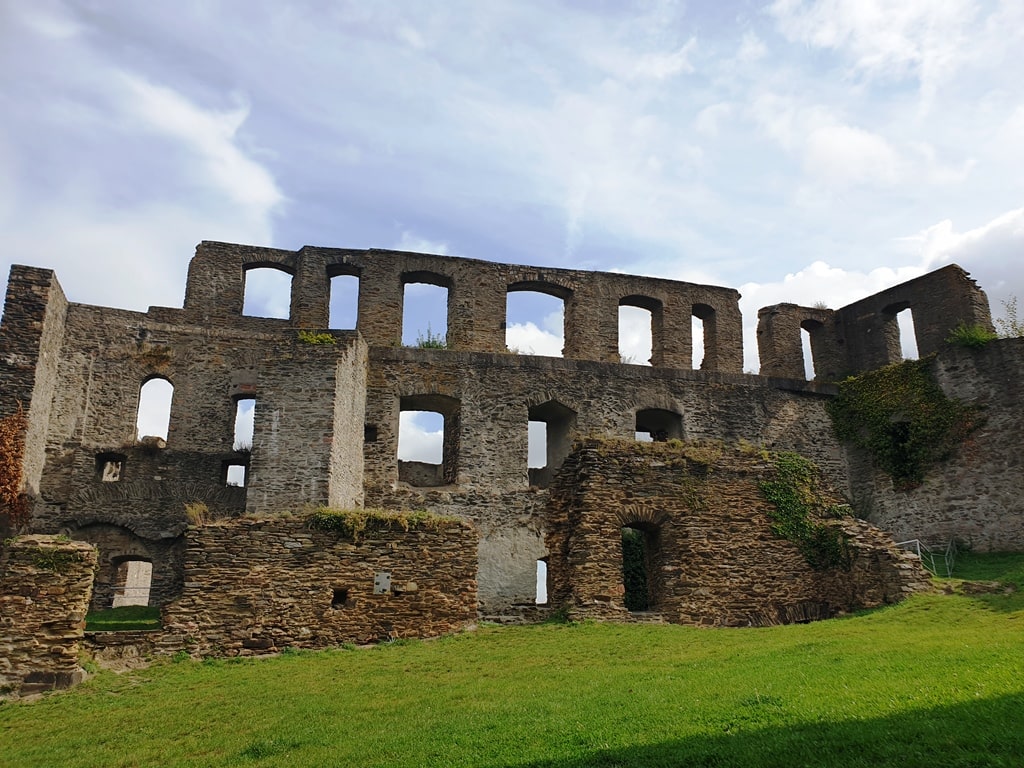Rheinfels Castle is a medieval ruin located above the town of St. Goar on the western bank of the River Rhine in Germany. Originally constructed in 1245, the castle underwent several expansions which saw it become the largest fortress in the middle-Rhine before it was ruined at the end of the 18th century. Today Rheinfels castle remains a spectacular sight, with expansive views across the Rhine, numerous nearby activities for visitors, and even features a hotel on the castle grounds.
Everything you need to know about Rheinfels Castle

History of Rheinfels Castle
Rheinfels Castle was built above the town of St. Goar in 1245 Count Dieter V of Katzenelnbogen, originally intended as a toll castle, which the lords of Katzenelnbogen could use to levy customs duties on traders and travelers passing up and down the Rhine. Rheinfels was one of a number of castles built along the middle Rhine with the intention of controlling access to the river and collecting tolls.

Over the following centuries, Rheinfels castle underwent a series of renovations and expansions, which turned it into the largest fortress along the middle-Rhine – at its height, it was the largest castle between the key cities of Koblenz and Mainz.

Thanks to its great strength and strategic positioning, Rheinfels was a primary target for any force attempting to invade the Rhine. As a result, it was besieged during the Thirty Years War (1618 – 1648) and the Nine Years War (1688 – 1697), although on both occasions the besiegers failed to capture the castle.
However, in the 1790s, Rheinfels fell to a French Revolutionary Army of some 28,000 men. Following the capture, the castle was deliberately damaged by the French troops, to ensure that it could not be held against them again.

The castle remains in a ruined state today, although it is still an incredibly impressive site to visit. In 1924 the castle was granted to the town of St. Goar by the state of the Rhineland-Palatinate, with the condition that it must not be sold on, although in 1998 the town leased some of the ruins to a nearby hotel, which converted a small section of the ruins into accommodation for guests.

This development led to controversy when in 2019 Georg Friedrich, Prince of Prussia, claimed ownership of Rheinfels castle, arguing that the town of St. Goar had breached the conditions of its ownership of the castle by allowing a hotel to occupy some of the sites. The case was thrown out of court, and St. Goar reached a settlement with the Prince out of court.
Description of Rheinfels Castle
Despite being ruined, a great deal of Rheinfels remains – the chapel is the only complete building that remains of the original castle, and today it houses the castle museum. The museum contains a model of the castle, which gives visitors an idea of how vast the castle complex was before it was ruined.
The chapel is located at the center of Rheinfels in the castle courtyard, a space that also used to contain a bakery, brewery, garden, well, and livestock pens. The inclusion of all these elements would have allowed Rheinfels castle to remain self-sufficient and kept the garrison supplied during a long siege.
Rheinfels castle was enormous – ordinarily, it housed some 300-600 people, although in the event of a siege it was able to accommodate up to 4,500, making it a formidable defensive site.
The castle was accessed by a gate tower, built around the year 1300. Once inside, a pathway leads visitors to the Darmstadt building, a large hall built in Tudor style with pointed gables, which contained the living quarters of the landgraves of Hesse-Darmstadt.
Further along is the inner courtyard, including the remains of the large central butter-churn tower which formed the defensive focal point of Rheinfels. The tower once stood some 54 meters tall, with a diameter of 10.5 meters and walls 3.5 meters thick at the base of the structure. In the 14th century, a narrow tower was added to the top, creating the distinctive ‘butter-churn’ tower design.

Rheinfels also featured a moat, which was later partially converted into a basement in the 1580s. A section of the old moat was vaulted over, creating an enormous 24 by 16-meter cellar, measuring 16 meters in height. Able to accommodate up to 400 people, the cellar was used for the storage of wine and other goods. The cellar was restored in 1997 and is used today for events of all kinds, such as conferences and performances.
Visiting Guide to Rheinfels Castle

Rheinfels is currently open to visitors, although due to coronavirus regulations visitors are required to register before they visit the castle. You can register by calling the ticket office on 0 67 41/77 53 or by visiting reservix.de. Contact registration can be completed at the castle ticket office, or here.
Note that guided tours are currently unavailable, and all visitors are required to wear a face mask while at Rheinfels castle.

Tickets cost 6 euros for adults, 4.50 euros for students and 3 euros for children. Family tickets and group tickets are also available. The castle is open every day from 10 am – 5 pm.
The castle stands above St. Goar, a town on the middle Rhine, located between the city of Koblenz and the town of Bingen. Federal Highway 9 passes through St. Goar, and Autobahn 61 is just a few minutes’ drive from the town, making it easily accessible by car.
Frankfurt (70km away), Koblenz (30km away), and Bingen (40km away) are nearby. St. Goar is also accessible by train, with regular services running from Cologne, Koblenz, Bingen, and Mainz.

Car parking tickets are available at the St. Goar public information office for 4 euros a day, and Rheinfels castle also has its own dedicated car park.
Visitors can even stay on the castle grounds at the Romantik Hotel Schloss Rheinfels, which is incorporated into a section of the castle ruin. Thanks to its position within the boundaries of the castle, the hotel has excellent views across the Rhine.
Aside from the castle, there are many attractions in and around the historic town of St. Goar. The town itself boasts a plethora of restaurants and cafes, as well as a series of hotels, apartments, Airbnb, and youth hostels that visitors can stay in.
Several hiking trails pass through St. Goar, such as the RheinBurgenWeg, and the Rhine Cycle Path offers visitors an excellent chance to get a spectacular view of an unspoiled countryside full of castles and vineyards.







